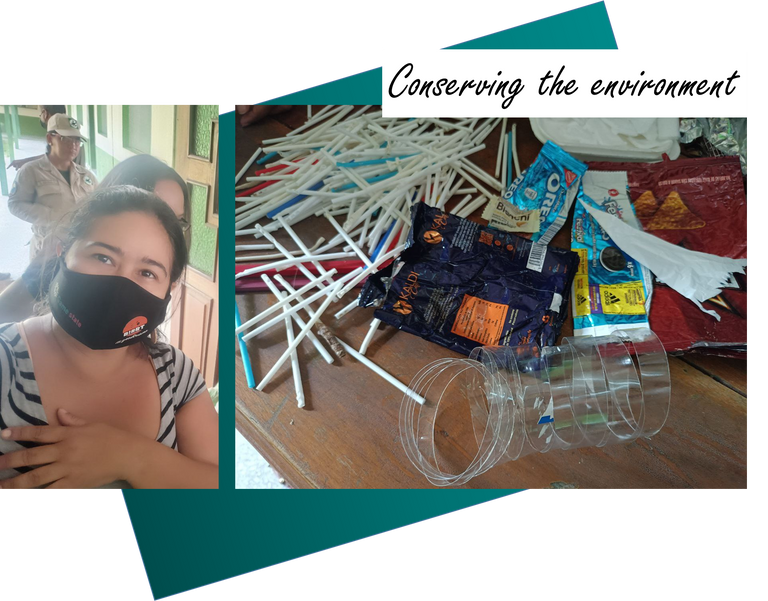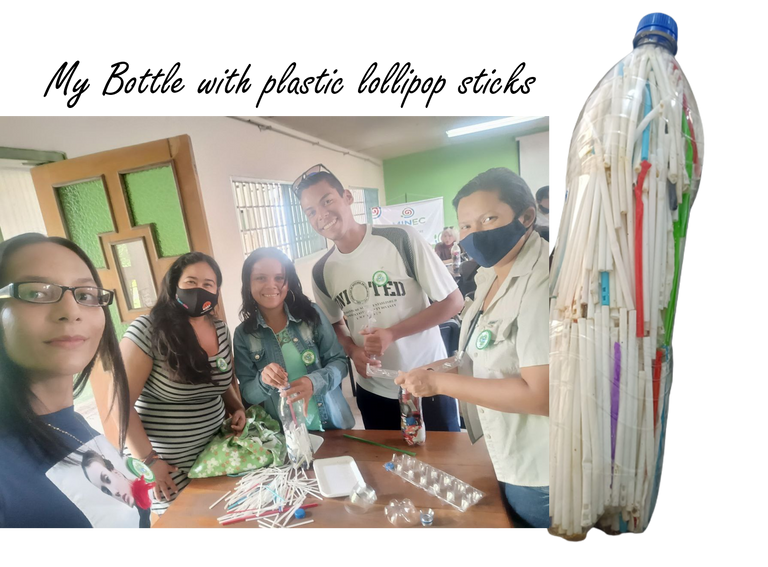In fact, my friend, who is also my allied researcher in a nearby town in the study of microplastics on the eastern coast of Venezuela, has adopted this practice since the beginning of this year, and, although I have been incorporating and changing several things in my daily routine had not yet considered this.
To be honest, as soon as I heard eco-bricks, I thought that it was linked to a process in which you could recycle plastics and we would use heat to melt and recover some plastics and that this would be the raw material to generate the bricks, but it turns out that it was the love bottles.
Although at first it was not what I expected and we listened carefully to get the most out of it. Because I have learned over time that we can always learn something and that everything, absolutely everything we learn is a gain.
The notebooks were not necessary, because in this case, we were going to learn by doing and also because the instructions were quite simple. Here I share the materials and instructions with some contributions that as a team we consider.

What is needed for eco-bricks?
To make the eco-brick you need the following:
- Clear plastic bottle
- Plastic snacks or candy bags
- Plastic lollipop sticks
- Foam
- A wooden or metal stick that allows you to crush the mat.
Instructions
Perhaps most importantly, everything must be completely dry: the bottle, the bags, and the rest of the materials that will go into the bottle. With the wooden stick, the materials must be pressed in such a way that complete compaction of the materials is achieved. In our work team, we thought of cutting the plastics and even the bottles that were available with scissors to continue filling the bottle. We also suggest that all small particles be incorporated into the bottles to prevent them from entering the environment.
I wish to invite each one of you to carry out actions that, no matter how small they may seem, contribute substantially to the conservation of our planet. Just by leaving spaces better than we found them, helping our neighborhood with cleaning, sorting waste and disposal, and trying to apply the 3 R's, there is a lot we can do.

Spanish version
Los eco-ladrillos o las botellas de amor
El término de botellas de amor lo había escuchado antes. Porque aunque básicamente me centro en la lectura de los aspectos más vinculados con la ciencia este año me he vuelto un poco más participativa en la parte social y de divulgación, puesto que he llegado a reconocer e internalizar que la ciencias es una herramienta poderosa que se puede emplear para lograr las transformaciones que requiere la humanidad. Sobre todo cuando hablamos de los patrones de consumo y de nuestra forma de gestión de los desechos. Porque aunque no se cuente con los medios para realizar reciclaje o los gobiernos no inviertan en programas para el desarrollo de sistemas de gestión de los residuos y desechos urbanos, nosotros, los ciudadanos podemos y debemos ser parte de la solución haciendo cambio en nuestro entorno y en nuestras prácticas. De tal forma que, mientras seamos más, mayor será el impacto positivo que logremos.
De hecho, mi amiga que además es mi investigadora aliada en una localidad cercana en el estudio de microplásticos en las costas del oriente de Venezuela, desde que inició este año a adoptado esta práctica y, aunque yo he venido incorporando y cambiando varias cosas en mi rutina diaria aún no había considerado esta.
Para ser honesta en cuanto escuché eco-ladrillos pensé que se vinculaba con un proceso en el podrías reciclar el plásticos y emplearíamos calor para fundir y recuperar algunos plásticos y que esto fuese la materia prima para generar los ladrillos, pero resulta que se trataba de las botellas de amor.
Aunque en principio no era lo que esperaba y escuchamos con atención para obtener el mayor provecho. Porque he aprendido con el tiempo que siempre podemos aprender algo y que todo, absolutamente todo lo que aprendamos es una ganancia.
Las libretas de apuntes no fueron necesarias, porque en este caso íbamos a aprender haciendo y porque además las instrucciones eran bastante sencillas. Aquí comparto los materiales y las instrucciones con algunos aportes que como equipo consideramos.
¿Qué se necesita para el eco-ladrillo?
Para hacer el eco-ladrillo se necesita lo siguiente:
1.Botella de plástico transparente
2.Bolsitas plásticas de merienda o golosinas
3.Palitos plásticos de Chupeta
4.Anime
5.Un palo de madera o metal que permita aplastar el material.
Instrucciones
Quizás lo más importante es que todo debe estar completamente seco: la botella, las bolsas y el resto de los materiales que se introducirán en la botella. Con el palo de madera se deben presionar los materiales de tal forma que se logre una compactación completa de los materiales. En nuestro equipo de trabajo ideamos cortar con una tijera los plásticos e incluso las botellas que estaban disponibles para seguir rellenando la botella. También sugerimos que todos las partículas pequeñas se incorporen a las botellas para evitar que se introduzcan en el ambiente.
Yo deseo invitarlos a cada uno de ustedes a llevar a cabo acciones que por muy pequeñas que parezcan contribuyan de forma sustancial a la conservación de nuestro planeta. Solo con dejar los espacios mejor que como los encontramos, colaborar en nuestro vecindario con la limpieza, clasificando los residuos y los desecho y tratando de aplicar las 3 R es mucho lo que podemos hacer.

Te invitamos a usar el tag #blurthispano. Nos puedes encontrar en Discord.
Curado manualmente por Geeklania.
Te invitamos a votar por @blurthispano como Witness.
Posted from https://blurtlatam.com
Gracias por compartir tu publicación en #Blurt. Tu esfuerzo significa mucho para nosotros; por eso has recibido un voto positivo.
Te invito a votar por @blurtlatam como Testigo / Witness
Congratulations, your post has been curated by @r2cornell-curate. Also, find us on Discord
Felicitaciones, su publication ha sido votado por @r2cornell-curate. También, encuéntranos en Discord